Business glossary
Overview
The TIBCO EBX® Business glossary communicates informational assets such as business concepts and their related terminology along with associated definitions and relationships. This is accomplished using an interface that provides access to data much in the same way as a traditional web-based front-end application. Because of the familiarity of this type of interface, you can quickly learn the ins and outs of the EBX® Business glossary and harness its ability to show detailed information about your data.
Authorized users can browse the glossary or search for information/metadata contained in an add-on repository. Different tabs show complete sets of information regarding the selected Administered item.
Special Notation: | |
|---|---|
| Please refer to the 'Business glossary' User Guide for a full description of the web application. |
To make the business glossary available to users, you have to configure the authorized users and the user preferences as described in the rest of this chapter. A 'Business Glossary' service in the 'Information Governance' data space (or any children) allows you to execute the business glossary inside EBX® UI:
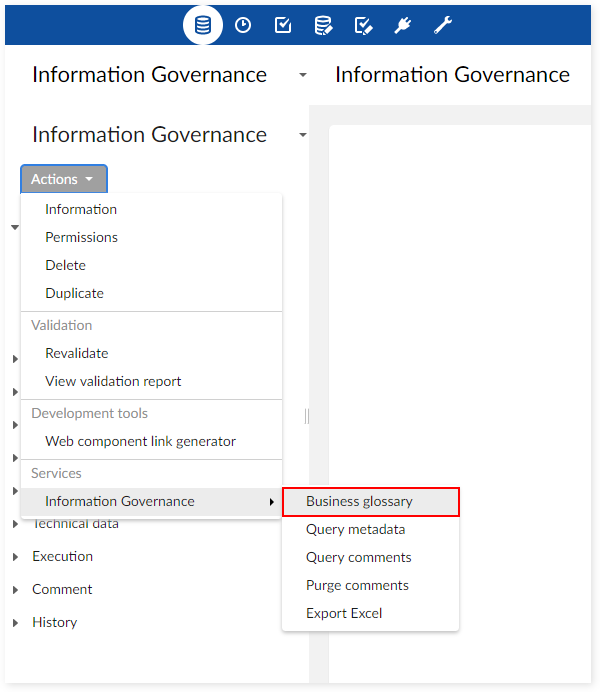
To execute the Business glossary outside the EBX® UI, you have to use the 'web component' process as documented in the EBX® Reference Manual under the 'Using EBX® as a web component' topic.
The next section highlights the process to configure the business glossary. The tables to configure are located in the Administration tab of EBX®, data space 'TIBCO EBX® Information Governance Add-on'.
Configuration
Administrators can access Business glossary configuration settings from the 'Administration' tab → 'Metadata management' group → 'TIBCO EBX® Information Governance Add-on' data space. The 'Business glossary' domain contains the following tables that determine glossary configuration:
Glossary preference
Glossary preference template
Tab label
Repository label
Glossary preference table
Each record in the Glossary preference table corresponds to a set of defined preferences for the Business glossary. Numerous properties afford you fine-grained control over what selected user profiles can see in the Business glossary. You can set each option manually, or specify a 'Glossary preference template'. When you specify a template, property values inherit those defined in the template. Even if you use a template, you can override individual properties to specify a custom value.
When viewing the 'Glossary preference' table, you can double-click to edit an existing set of preferences, or click the '+' icon to create a new set. The following sections describe the options you can edit.
General properties in the 'Home' tab
The following table describes the general properties in the 'Home' tab that allow you to turn the Business glossary on/off and specify which templates to use:
Property | Definition |
|---|---|
User profile | The user profile(s) that this glossary preference record applies to. This drop-down list pre-populates with available profiles. |
IGov repository | The add-on repository that this glossary preference configuration applies to. This drop-down list populates with existing repositories. |
Is active | With Yes selected here, the glossary preference configuration is active. Selecting No deactivates the configuration. |
Is default | With Yes selected here, this glossary preference configuration automatically displays when users enter the Business glossary. |
Glossary preference template | The Glossary preference template used for this configuration. After selecting a template, you click Save to populate the remaining configuration properties with the values defined in the selected template. |
Header title | The text you enter in this field and the description box below displays as the Business glossary header and description, respectively. |
Header image | The Header image group allows you to choose an image to display as the Business glossary icon and specify its default size
|
Administrator contact email | An email address to contact the Business glossary's administrator. |
Link to Reference data | With 'Yes' selected, a link from the metadata to the actual data is available. For example, from the 'Client' Object class, a link allows the user to display the content of the 'Client' table. The display takes into consideration EBX® user permissions. |
Is search active | This property determines whether or not users assigned to this configuration can use the Search tab. |
Show header by default | Determines whether the Business Glossary header automatically displays when users open the glossary. |
Default tab | This property determines the default active tab in the Business glossary's Query panel. You can choose from 'Search', 'Browse', or 'List view'. |
Results per page | The number of results shown per page. |
Default context | This drop-down list allows you to select the context that loads by default when the Business glossary is opened. |
Allowed context | Each context listed here will show up in the Context drop-down list. To add a context click the plus icon. |
Default data view | This is the default view when browsing the Administered items. |
Allowed data model | When you add a data model to this list, users can access it in the Business Glossary. By leaving the property undefined you place no restrictions on data model access. Please note that if an allowed data model contains no Items, users will not see it in the 'Browse' tab even if it is allowed. |
Allowed data view | Occurrences added to this list will also be shown and selectable when users enter the Business glossary. |
Table 1: General configuration properties
The Tab display tab
The 'Tab display' tab allows you to specify which tabs display when users enter the Business glossary. Additionally, you can use the 'Label' property to customize each tab's label display.
To set tab display, either allow it to inherit from, or overwrite the template values. The square icon after each tab name toggles inheritance on and off. If changing values:
Set the corresponding tab's 'Is displayed' property to 'Yes', or 'No'.
You can optionally change the tab's label, or create a new one using the 'Label' drop-down list. If left undefined, each tab uses the standard label.
After saving and closing, all affected tabs and labels update.
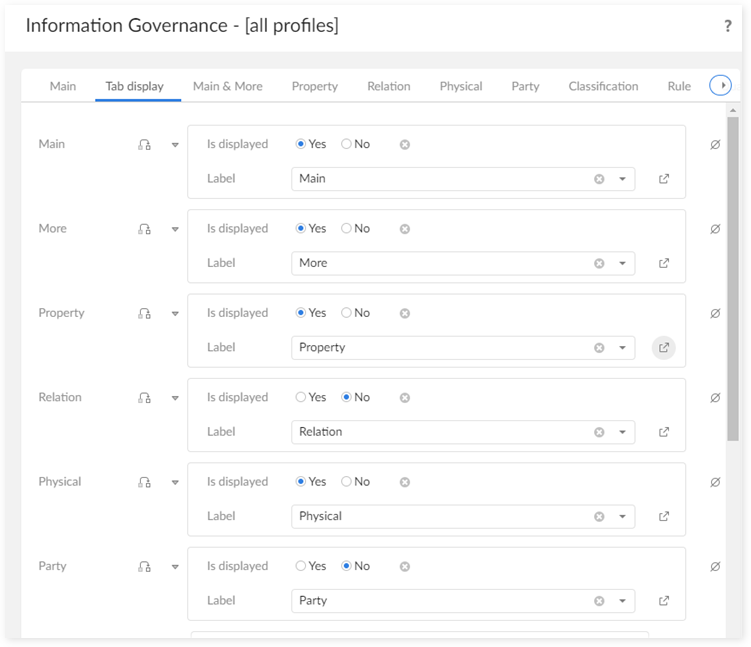
Main & More tab
This tab allows you to limit the information that displays when the user profiles associated with this configuration view the Business glossary 'Main', 'More', or 'Physical' tabs. By default each group inherits settings from the 'Glossary preference template' specified on the 'Home' tab. Before altering any values, you need to override this inheritance by clicking the small box after the group name. For example, the configuration shown in the following image determines that the 'Data repository' field only displays in the 'Physical' tab when the field contains a value.
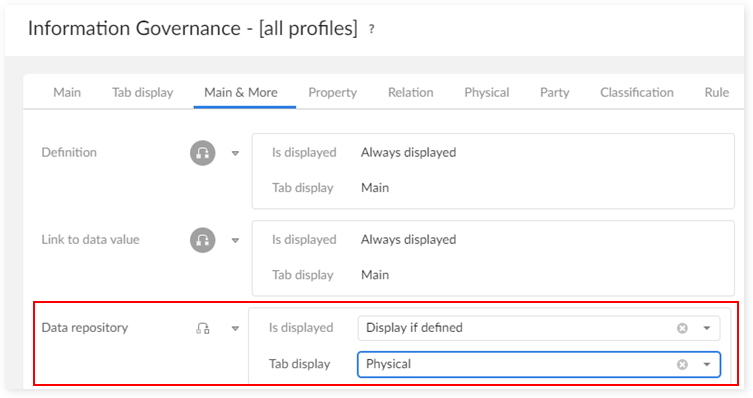
Property tab
This tab allows you to choose which columns display when the user profiles associated with this configuration view the Business glossary's 'Property' tab. Each field displayed here represents a column in the 'Property' tab's table. By default each group inherits settings from the 'Glossary preference template' specified on the 'Home' tab. Before altering any values, you need to override this inheritance by clicking the small box after the field name.
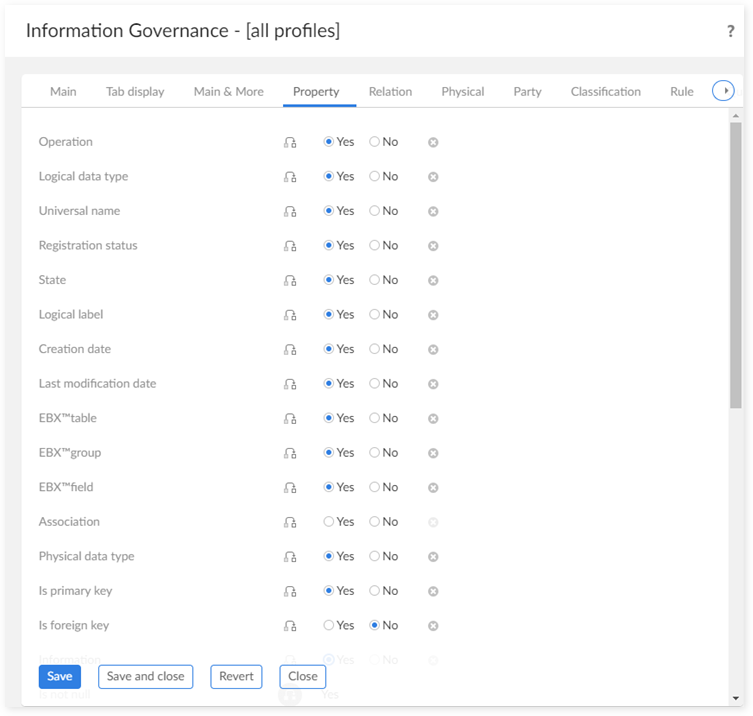
Relation tab
Groups on this tab represent tables that can display in the Business glossary's 'Relation' tab. The fields in each group correspond to the table columns. Selecting Yes or No determines whether the associated column displays for user profiles associated with this configuration. By default each group inherits settings from the 'Glossary preference template' specified on the 'Home' tab. Before altering any values, you need to override this inheritance by clicking the small box after the group name.
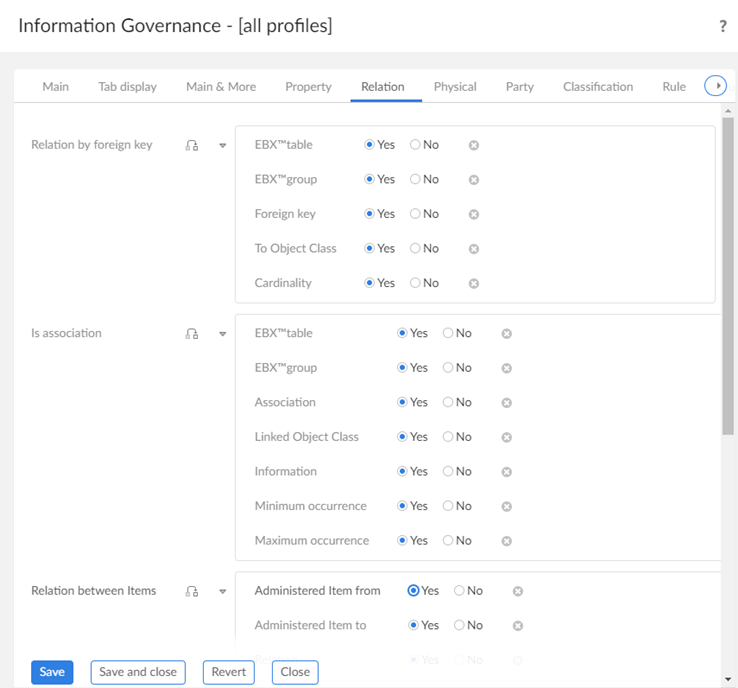
Physical tab
Each group on this tab represents types of data assets associated with Administered Items. Their 'Tab display' properties indicate on which Business glossary tab this group displays. After each field name, a status indicates whether the field displays, or if it only can be seen when defined. By default each group inherits settings from the 'Glossary preference template' specified on the 'Home' tab. Before altering any values, you need to override this inheritance by clicking the small box after the group name.
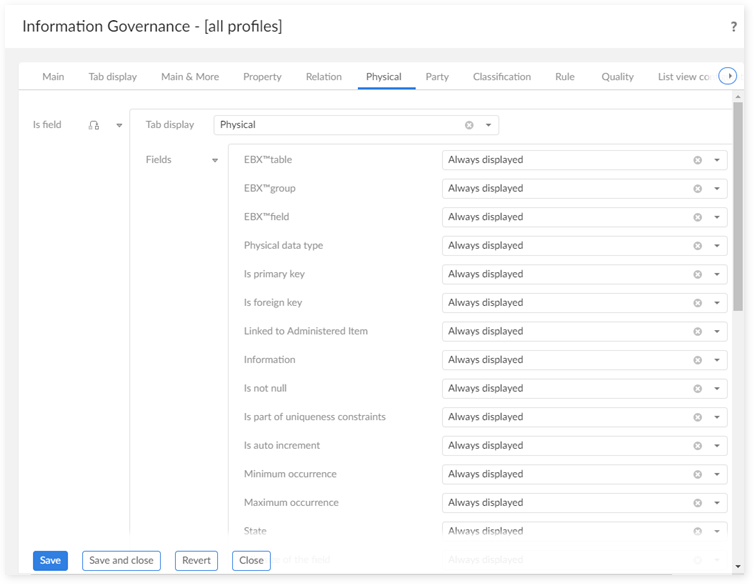
Party tab
This tab displays the possible columns that display on the Business glossary's 'Party' tab. You can choose which columns display for user profiles associated with this configuration. By default each group inherits settings from the 'Glossary preference template' specified on the 'Home' tab. Before altering any values, you need to override this inheritance by clicking the small box after the column name.

Classification tab
This tab allows you to choose which type of view displays when user profiles associated with this configuration view the Business glossary's 'Classification' tab. By default these settings are inherited from the 'Glossary preference template' specified on the 'Home' tab. Before altering any values, you need to override this inheritance by clicking the small box after the column name.

Rule tab
Each field on this tab corresponds to a column that displays when user profiles associated with this configuration view the Business glossary's Rule tab. You can choose which columns display for these users by specifying Yes or No. By default these settings are inherited from the 'Glossary preference template' specified on the 'Home' tab. Before altering any values, you need to override this inheritance by clicking the small box after the column name.
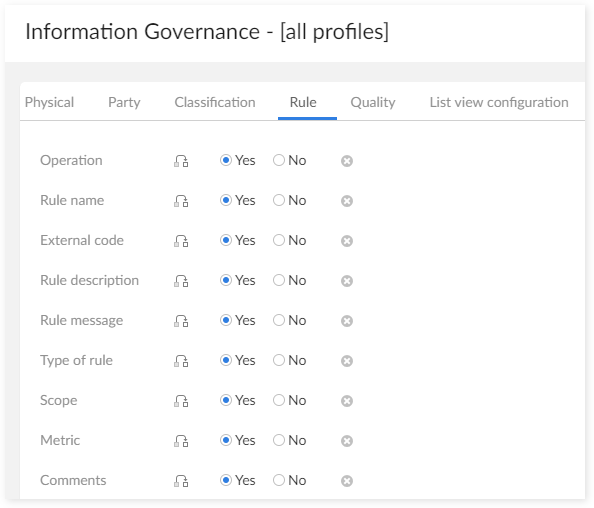
Quality tab
This tab allows you to determine which percentages of completion display when user profiles associated with this configuration view the Business glossary's 'Quality' tab. By default these settings are inherited from the 'Glossary preference template' specified on the 'Home' tab. Before altering any values, you need to override this inheritance by clicking the small box after the field name.
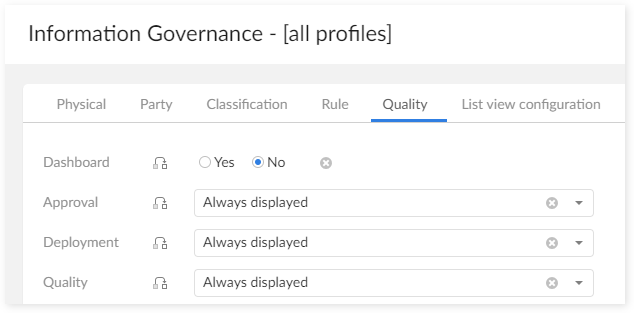
List view configuration tab
This tab allows you to enable or disable 'List view' tab display, specify the number of items shown per page and specify the columns shown. These settings apply to the user profiles associated with this configuration. By default these settings inherit from the 'Glossary preference template' specified on the 'Home' tab. Before altering any values, you need to override this inheritance by clicking the small box after the field name.
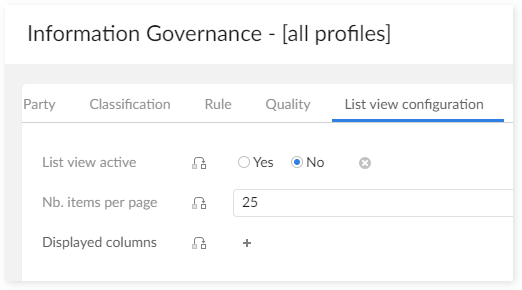
Search configuration tab
The 'Search configuration' tab allows you to adapt Business glossary fuzzy search results. By default these settings inherit from the 'Glossary preference template' specified on the 'Home' tab. Before altering any values, you need to override this inheritance by clicking the small box after the field name.
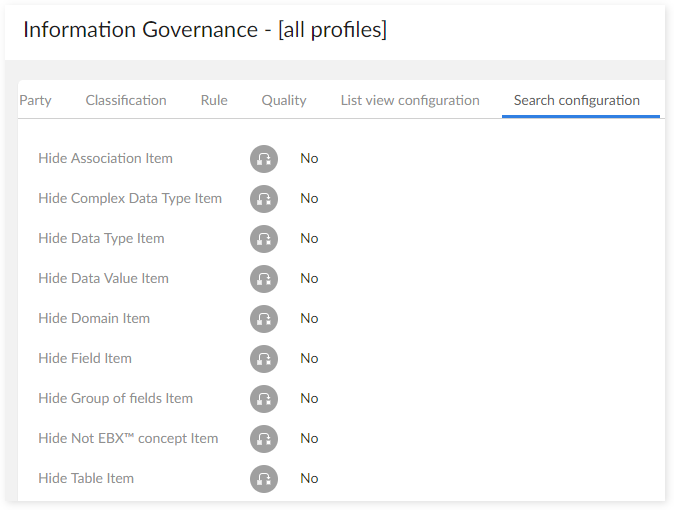
Icon bar tab
This tab allows you to enable display of informational icons in the Business Glossary's Icon bar. When users select an Administered Item (Object Class or Property) the icons that display provide a quick-reference to the Item's corresponding field value. For example, if an Item's 'Registration' field value is 'Unregistered', users can see the icon representing this value without having to navigate to another tab.
To configure icon display:
Override field inheritance for the desired Administered Item type. By overriding the 'Object Class' field inheritance the icon categories you enable will display each time a user selects an Item considered an Object Class. This also applies to the 'Property' field.
Click '+' and select an icon category from the drop-down list. You can repeat this process to add multiple categories. The icons display in the Glossary in the order shown here. You can use the arrows to re-order, or the trash can to remove categories.
Save and close when finished.
![]()
The image below shows the result of the above configuration with an Object Class selected.
![]()
Data model tab
This tab allows you to determine whether a data model's definition displays when a user selects it in the Business Glossary. When you enable the display, you can also configure what information displays by toggling the corresponding properties on and off.
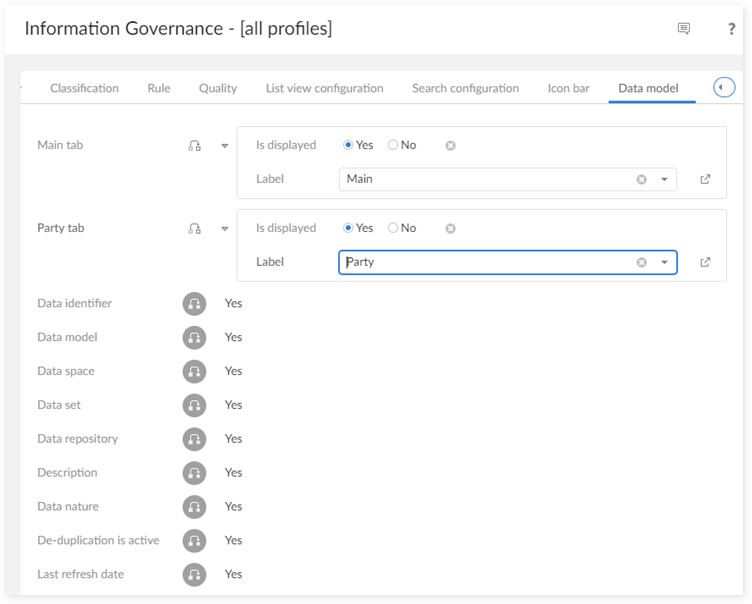
Glossary preference template table
The Glossary preference template table allows you to pre-define templates for use in defining a Glossary preference. Two pre-defined templates are provided: [ON] Full view and [ON] Simple view. These templates cannot be deleted. The [ON] Full view template enables users assigned to this template to see all tabs and fields. The [ON] Simple view template:
Shows only the Main, More and Property tabs
Hides the item's history
Hides the Is field, Is table, Is D.E.C. and Is data type
Disables the Search tab
See the above 'Glossary preference table' section for descriptions of template properties.
Tab label
Each record in this table corresponds to a label you can use for Business Glossary tabs. Any labels with a prefix of [ON] are unmodifiable. However, you can create and delete your own labels using the + icon and Actions menu, respectively.
Repository labeling
The Repository label table allows you to create labels for add-on repositories. The Business glossary uses these labels as identifiers (in the Identification tool bar) when the glossary executes outside the EBX® UI. If you don't define a label, the system uses the default data set label.